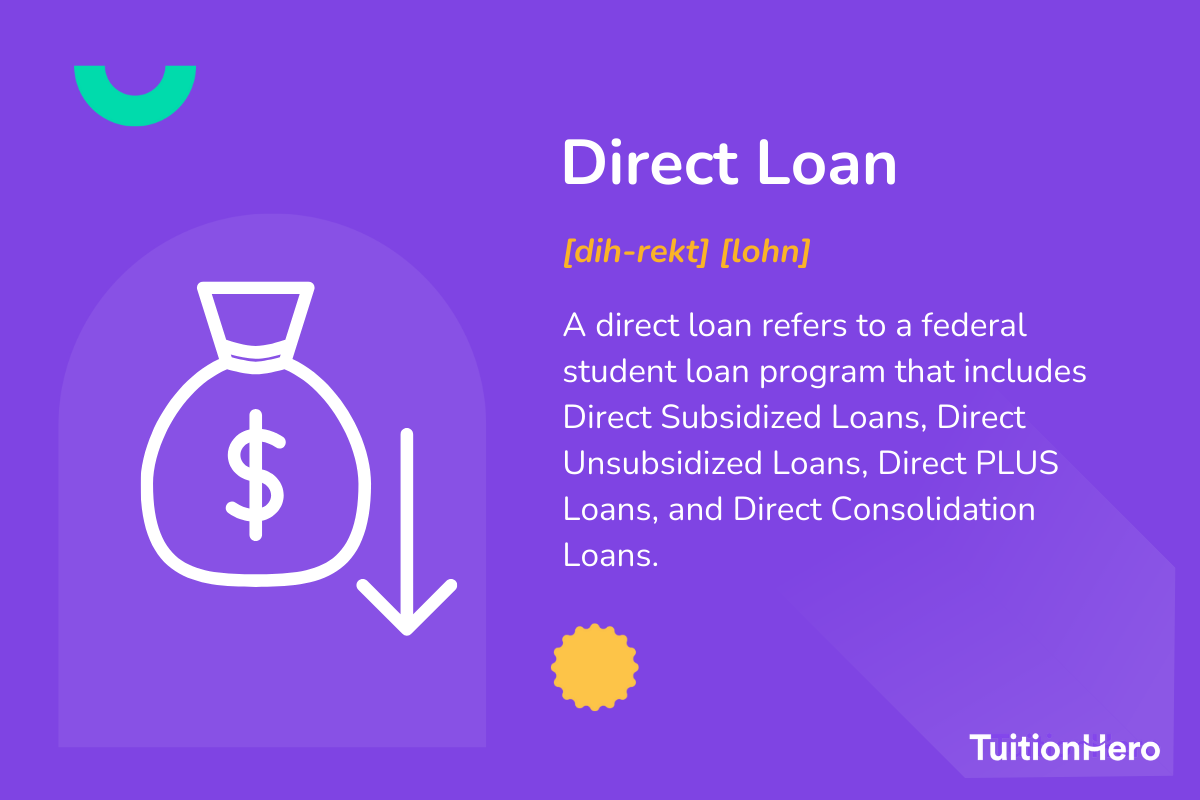Advertiser Disclosure
Last update: November 17, 2024
6 minutes read
What Is a Direct Loan?
Learn all about Federal Direct Loans. Explore types, eligibility, tips for smart borrowing, and how to simplify your education financing with different loan options.

By Brian Flaherty, B.A. Economics
Edited by Rachel Lauren, B.A. in Business and Political Economy
Learn more about our editorial standards



By Brian Flaherty, B.A. Economics
Edited by Rachel Lauren, B.A. in Business and Political Economy
Learn more about our editorial standards
When talking about paying for education, it's important to know about different types of student loans. Let's look at Direct Loans, a type of loan people use a lot but might not completely understand. By the end of this article, you'll learn the basics of Direct Loans and how they can make a big difference in paying for school. If you're thinking about how to handle the loans you already have, learning about your student loan options can give you some helpful ideas.

Key takeaways
- There are four main types of Direct Loans: Subsidized, Unsubsidized, PLUS, and Consolidation Loans
- Complete the FAFSA early to determine your eligibility for Direct Loans
- It’s important to consider both advantages and disadvantages before taking out Direct Loans
What is a direct loan?
A Federal Direct Loan is a type of student loan given directly by the U.S. Department of Education. These loans are important to understand for students and parents dealing with the costs of college.
There are four main types of Direct Loans, each serving different needs. What makes them special is that they have low interest rates and protections for borrowers.
Whether you're an undergrad, grad student, or a parent, there's a Direct Loan that fits your situation. These loans help make navigating college easier by not requiring payments while you're in school and making it easier to repay once you graduate. If you want to find out if you can get a Direct Loan, start by filling out a Free Application for Federal Student Aid (FAFSA).

Here's a breakdown of the Direct Loan types you might encounter:
- Direct Subsidized Loans: Ideal for undergraduate students demonstrating financial need. The government pays the interest while you're in school and during a grace period post-graduation.
- Direct Unsubsidized Loans: Accessible to all students, regardless of financial need. Interest accumulates while you’re in school, but you do not need to start repayments until 6 months post-graduation.
- Direct PLUS Loans: For the parents of undergrads or for graduate students themselves, these loans offer more support, irrespective of financial need, but typically have higher interest rates.
- Direct Consolidation Loans: A smart move for rolling multiple federal student loans into one, simplifying repayments.

TuitionHero Tip
For a deeper dive into managing your student loans effectively, consider exploring options for private student loans and understand how they can complement your financial strategy for education.
How to apply for a Direct Loan
Applying for Direct Loans is easy. To get these loans, fill out the Free Application for Federal Student Aid (FAFSA).
FAFSA submission
The FAFSA opens annually on October 1 (though it went live in December 2023), acting as your gateway to federal student aid. Using tax returns and official documents, it assesses your expected family contribution and determines your eligibility for many forms of federal aid, including Direct Loans. It's the first step toward managing your education costs efficiently.
After the FAFSA
Once your FAFSA is processed, your school will inform you of your financial aid offer via an award letter. This includes eligibility for Direct Loans. Accepting these loans involves completing entrance counseling to understand your obligations, and signing a Master Promissory Note, which outlines loan details and repayment responsibilities.
The borrowing limits explained
It's crucial to understand how much you can borrow, as Direct Loans come with specific caps depending on your status as a student and the type of loan.
Undergraduate borrowing limits
Dependent undergraduates can borrow up to $31,000 across their entire schooling, of which no more than $23,000 can be in subsidized loans. Independent undergraduates have a higher limit of $57,500, with the same cap on subsidized loans.
Graduate borrowing limits
For graduate or professional students, the limits increase notably. They can borrow up to $138,500 in Direct Unsubsidized Loans, with a limit of $65,500 available for subsidized loans, depending on their program and financial need.
Compare private student loans now
TuitionHero simplifies your student loan decision, with multiple top loans side-by-side.
Compare Rates
Federal Direct Loans vs. Private student loans
When it comes to funding your education, it's important to compare all available options. Federal Direct Loans and private student loans serve similar purposes but differ in key aspects.
Interest rates and requirements
Federal Direct Loans offer fixed interest rates, making them a predictable and usually more affordable option than private student loans, which may have variable rates. Eligibility for federal loans doesn't depend on credit scores or income, unlike private loans.
In addition, Direct Loans tend to have lower interest rates than private loans. However, the rate you’re offered by a private lender will vary depending on your credit score and background, so make sure to check out both options before making a final decision.
Repayment flexibility
Direct Loans offer flexibility when it comes to repaying the money you borrowed. They have helpful options like deferment, loan forgiveness, and income-driven repayment plans.
This safety net can be really useful if you’re facing financial difficulties. On the other hand, private loans don't usually give you this kind of flexibility. That's why many people find federal loans to be a better choice if you can get them.
Now, let's go a bit deeper into Direct Loans. We'll talk about how to apply for them, the maximum amount you can borrow, and how they compare to private student loans. Understanding these details will help you make smart decisions based on your financial situation and long-term education plans.
Dos and don'ts of applying for a Direct Loan
When considering Direct Loans as a financing option for education, it's important to approach the application process with a clear strategy. Understanding the dos and don'ts can significantly affect the outcome and efficiency of getting the funds you need. Below is a table outlining key actions to follow and avoid.
Do
Do complete the FAFSA early.
Do review and understand the loan types available to you.
Do consider your future ability to repay when choosing loan amounts.
Do keep copies of all documents for future reference.
Don't
Don't overlook the need for entrance counseling.
Don't borrow more than you need.
Don't ignore the terms and conditions of your loan.
Don't hesitate to ask for help if you're confused.
Advantages and disadvantages of federal Direct Loans
Taking out a Direct Loan, like any money decision, has its pros and cons. Let’s dig into them.
- Fixed interest rates provide predictability over the loan's lifespan.
- Deferment and forbearance options offer flexibility during financial difficulties.
- Opportunities for loan forgiveness under specific conditions.
- No credit check is required for most Direct Loans (except for Direct PLUS Loans).
- Loan borrowing limits may not cover the full cost of college, leading to a funding gap.
- Interest on unsubsidized loans accumulates while in school, increasing the total loan amount.
- The application process can be complex and requires reapplication each year.
- Direct PLUS Loans come with a credit check, which can limit availability for some borrowers.

Why trust TuitionHero
At TuitionHero, we simplify paying for school. We guide you through federal Direct Loans, private student loans, and scholarships. Our goal is to make college finance easy to grasp. Let us help you create a confident financial plan.
Frequently asked questions (FAQ)
Deciding between a subsidized and an unsubsidized Direct Loan depends on your financial need and status as a student. Subsidized loans are ideal for undergraduate students with demonstrated financial need, as the government covers the interest while you're in school and for a short period after graduation.
Unsubsidized loans are available to both undergraduate and graduate students regardless of financial need, but interest accumulates immediately. As a result, if you qualify, subsidized loans are always the better option.
Yes, you can explore options to refinance your Direct Loans through TuitionHero. We connect students and parents with lenders offering competitive refinancing options that could potentially lower their interest rates and monthly payments.
Refinancing could be a strategic move to consolidate multiple loans into a single payment or secure more favorable terms. For more details on how refinancing works and how it might benefit you, check out our comprehensive guide on how to refinance student loans.
Yes, lots of scholarships can help you pay for school along with Direct Loans. TuitionHero has a big list of scholarships for students in different grades.
If you get scholarships, you won't have to borrow as much money, making it easier after you finish school. Look for scholarships early to increase your chances of getting them. Check out our scholarships page to see what's available.
Yes, Direct Loans can be used to cover education-related expenses beyond just tuition. This includes room and board, books, supplies, transportation, and even personal expenses.
The key is to manage your budget wisely and borrow only what you need, as everything borrowed must be paid back with interest. For strategies on managing your loans and educational expenses more effectively, TuitionHero provides resources and tools that can help make your financial planning more manageable.
Final thoughts
When it comes to paying for your education, it's important to be well-informed. Federal Direct Loans can help you reach your educational goals, but it's crucial to understand how they work.
Take a close look at the different types of loans, the repayment terms, and any financial aid options like scholarships. This way, you can create a plan that combines your ambitions with smart financial decisions. Keep in mind that the decisions you make now about your student loans can affect your finances in the long run.
Source
Author

Brian Flaherty
Brian is a graduate of the University of Virginia where he earned a B.A. in Economics. After graduation, Brian spent four years working at a wealth management firm advising high-net-worth investors and institutions. During his time there, he passed the rigorous Series 65 exam and rose to a high-level strategy position.
Editor

Rachel Lauren
Rachel Lauren is the co-founder and COO of Debbie, a tech startup that offers an app to help people pay off their credit card debt for good through rewards and behavioral psychology. She was previously a venture capital investor at BDMI, as well as an equity research analyst at Credit Suisse.
At TuitionHero, we're not just passionate about our work - we take immense pride in it. Our dedicated team of writers diligently follows strict editorial standards, ensuring that every piece of content we publish is accurate, current, and highly valuable. We don't just strive for quality; we aim for excellence.
Related posts
While you're at it, here are some other college finance-related blog posts you might be interested in.
Shop and compare student financing options - 100% free!

Always free, always fast
TuitionHero is 100% free to use. Here, you can instantly view and compare multiple top lenders side-by-side.

Won’t affect credit score
Don’t worry – checking your rates with TuitionHero never impacts your credit score!

Safe and secure
We take your information's security seriously. We apply industry best practices to ensure your data is safe.
Finished scrolling? Start saving & find your private student loan rate today





